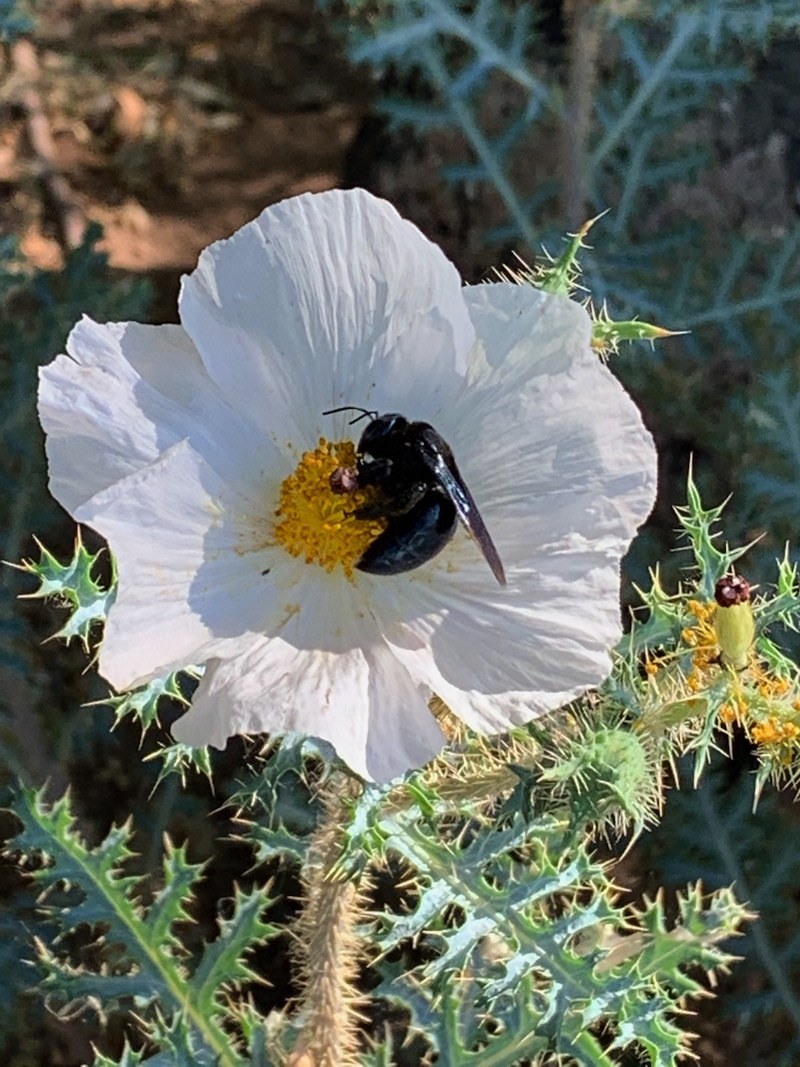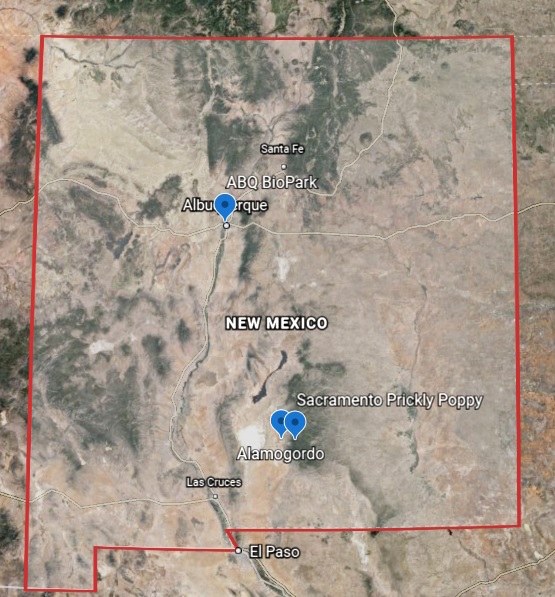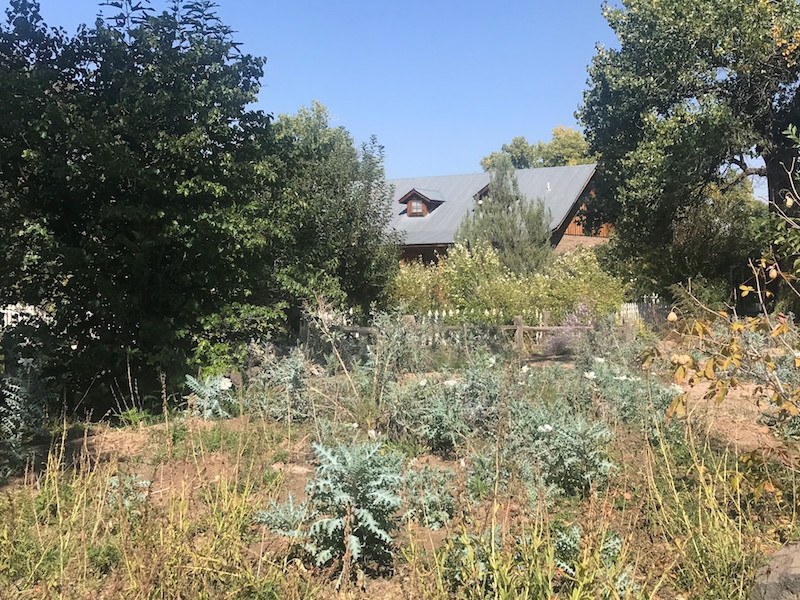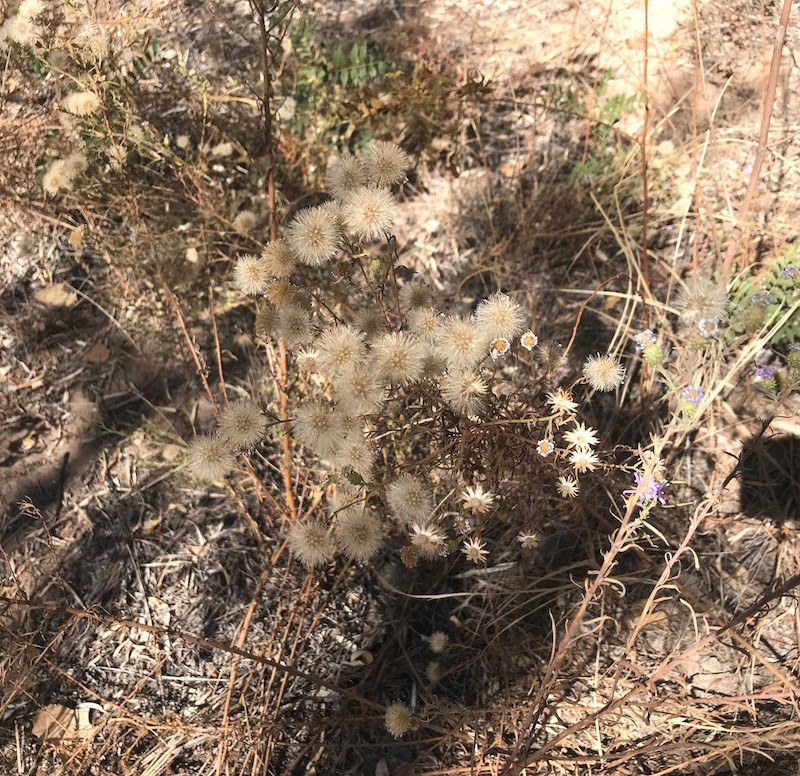Sacramento Prickly Poppy
Learn about this New Mexico native plant and learn how to collect and germinate your own seeds.
About the Sacramento Prickly Poppy
Here at the BioPark, we work every day to help save threatened and endangered species, including Asian elephants, Mexican gray wolves, white rhinos and many more animals. You might not think of it as much, but we also work to save endangered plants! One of these plants is the Sacramento prickly poppy.

This beautiful yet spiny plant grows only one place in the world: here in New Mexico! In the wild it’s found only in a small area east of Alamogordo on the western slope of the Sacramento Mountains in the Lincoln National Forest.

The Sacramento prickly poppy is a perennial plant, which means that it lives through the winter, and one plant can live 10-15 years. Each year it produces beautiful white flowers and seeds from May to August. This plant can grow in relatively dry, rocky or disturbed soil, but it can be killed by drought. Other threats to this flower include trampling by grazing cattle or by people, road building, flash flooding and fungal disease.

How the ABQ BioPark Works with the Sacramento Prickly Poppy
Here at the BioPark, horticulturalists are growing this endangered plant to help preserve it, learn more about it, and save its seeds in case scientists need to plant more in the future.
The Heritage Farm’s Sacramento prickly poppy collection is a living seed bank. Flowers are grown, then bees and other insects pollinate them, and seeds are produced. Horticulturalists at the BioPark collect these seeds, then germinate them—in other words, start them growing—in the safety of our greenhouses. When the Sacramento prickly poppies are big enough, horticulture staff members plant them in the soil at Poppy Hill near the farmhouse. Seeds are also be saved in the BioPark’s conservation seed fridge.
Activity
While you shouldn’t try to germinate endangered plants like the Sacramento prickly poppy at home, you can collect seeds from plants growing in your neighborhood or even from plants you eat! You can save these seeds to plant in the spring or start growing them in a pot in a sunny window right away. Let’s talk about how to collect seeds and then we’ll talk about how to get them to grow.
Collecting Seeds
Plants all around us make seeds every year and many are ready to leave their parent plants in the fall. There are a few different methods of collecting seeds we can use.
One way to find seeds is to look for flowers that have made seed heads. Flowers like asters, dandelions and sunflowers have seeds that are ready to drop from their parent plant and overwinter. These plants might be growing in your yard or you might find them near sidewalks or in empty lots. Make sure a grown-up comes with you if you’re leaving your yard to look for seeds! Collect a few of these seeds, but don’t take too many; they’re an important food for birds and small mammals to save for winter.

Another way to find seeds is to look for ones that have already been dropped on the ground. They tend to hide in grass and dirt but many of them will stick to fur. Humans, of course, don’t have much fur, but we can get a similar effect using socks! Place a large, inside-out sock on over your shoe and go for a walk in a wild area. You’ll be amazed what seeds will stick! You can pull the seeds off of the sock and store them away. You can also put an inside-out sock over your hand and run it gently through a weedy area to gather seeds. Be careful! Just like the Sacramento prickly poppy, a lot of New Mexico’s plants are spiny!
Another way to collect seeds is from food plants. Seeds are only found in the fruit of plants like apples and oranges. Some foods that we think of as vegetables like tomatoes, squash and chile are really fruits. You can use dry beans from the pantry, too. Gather the seeds you want to save, rinse them off well, and set them on a towel or piece of paper to dry. You want to put them somewhere dark, like in a cupboard, while they’re drying. In a week or so, when the seeds are completely dry, you can store them away. If you want to store your seeds until spring, you can put them in a paper envelope or a plastic baggie. Write where you got the seeds and the date you saved them on the envelope. Then put them somewhere safe until spring. Or, if you want to start your seeds inside, read on for instructions!
Germinating Seeds
To grow your seeds, you’ll need soil and a small container. Potting soil will work best, but you can use soil from outside too. For a container, see if you have anything in the recycling bin you can use. Egg cartons, the bottom part of a soda or water bottle, or a toilet paper tube with a squished end can all work. You can even fold newspaper into origami pots. If you use something that water can’t get through like plastic or metal, poke some holes in the bottom. You can actually drown plant seeds if you put too much water in their soil, so make sure your little pot can drain.
Place your seed just under the soil in your little pot. Pour clean water in until the soil is wet all the way through, but not completely soaked. Place your pot on a plate and set it somewhere sunny to grow. If you’re planting more than one seed, label the pots so you know what grows. Water the seeds every two days or so, keeping the soil damp. In one to two weeks your seed should start to sprout!
More information
Check out these resources for more information about the Sacramento prickly poppy:
- New Mexico Rare Plants
- U.S. Fish and Wildlife Service Makes the Endangered Sacramento Prickly Poppy a Spotlight Species
- US Fish & Wildlife ECOS listing
Check out these resources for more information about collecting and germinating seeds for kids:
- kidsgardening.org
- https://www.dirtgirlworld.com/blog/seed-saving-for-kids
- seedsavers.org/learn
- The Albuquerque/Bernalillo County Public Library has a seed library! https://abqlibrary.org/seeds
